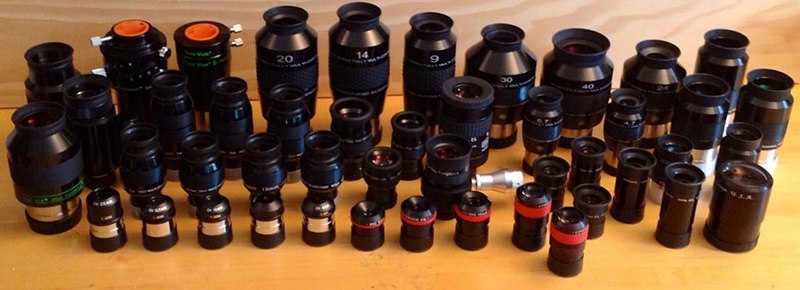
Beginners often underestimate the significance of the eyepiece, mistakenly believing that the objective lens diameter is the most important aspect of a telescope. However, selecting the appropriate eyepiece can greatly enhance the telescope’s capabilities for various types of observations. In this article, I will discuss the nature of eyepieces, their variations, and the ideal eyepiece to purchase.
In essence, the key parameters of eyepieces are as follows:
1. Focal length
2. Barrel diameter (1.25…3 inches)
3. Field of view (38 to 120 degrees)
4. Eye relief
5. Eyecup design
6. Optical design
7. Coatings
8. Brand (manufacturer)
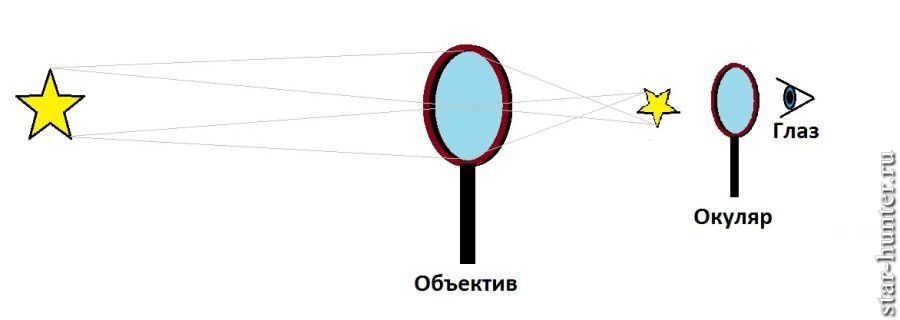
When we look through the eyepiece, we see the image that the telescope lens forms in the focal plane. To help you understand better, let’s imagine two magnifying glasses – a large one as the objective and a small one as the eyepiece.
Many beginners make the mistake of immediately setting their telescope to maximum magnification and then are surprised when they can’t see anything but darkness. The truth is, some celestial objects are best observed with high magnification (like planets, the Moon, and double stars), while others are best observed with minimum or medium magnification (like galaxies, nebulae, and clusters). Keep in mind that the higher the magnification of the telescope, the dimmer the image becomes and the worse the contrast. If you use excessive magnification when observing planets, all you’ll see is a blurry, faint spot.
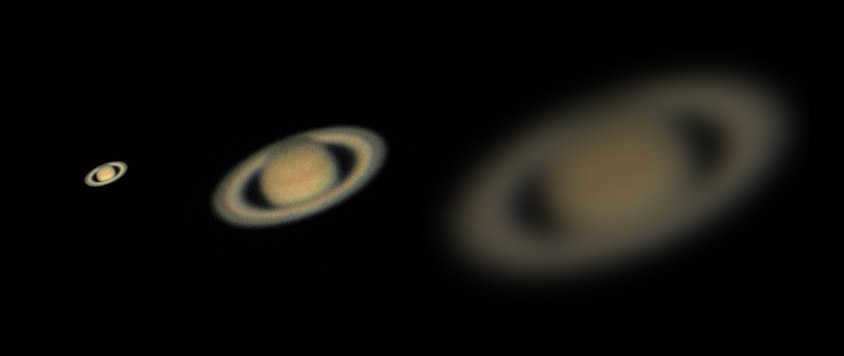

Observing Saturn through a telescope at different magnifications reveals that the level of detail is not solely determined by the highest magnification.
1. Focal Length
The focal length is a crucial parameter of an eyepiece. It is typically mentioned in the name and labeling of the eyepiece (e.g. Explore Scientific 11mm 82 degrees). The concept is straightforward: a shorter focal length of the eyepiece results in a higher magnification of the telescope. The telescope’s magnification can be determined by dividing its focal length by the eyepiece’s focal length. For example, if the telescope has a focal length of 1000mm and the eyepiece has a focal length of 10mm, the magnification is 100x. Eyepieces can have focal lengths ranging from 56mm to 2mm.
The maximum magnification of a telescope is dependent on the diameter of its objective lens and is approximately equal to 1.5*D…2*D, where D is the diameter of the objective lens in mm. Therefore, for a 150mm telescope with high-quality optics, the maximum magnification is around 300x.
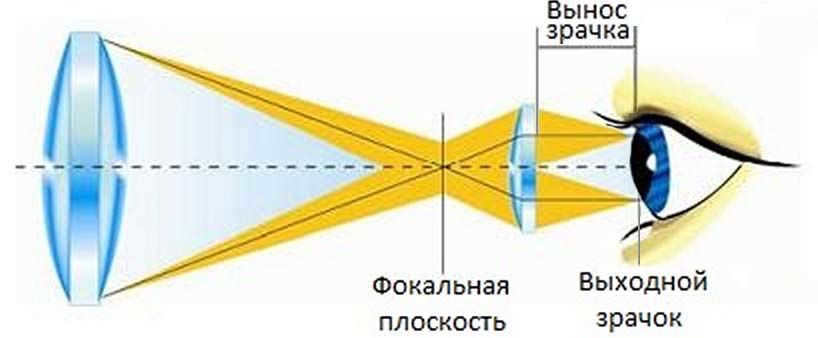
When it comes to telescopes, there are three important terms to understand: focal plane, pupil outreach, and exit pupil.
In order to calculate the size of the exit beam, also known as the exit pupil, you need to divide the diameter of the telescope by the magnification. For instance, if you have a 300mm telescope with a magnification of 100x, the exit pupil would be 3 millimeters.
Various magnifications are employed for observing different celestial objects.
| Magnification | Name | exit pupil (mm) | Observed objects |
| D/5…D/7 | equal-transparent | 5-7 | search eyepiece, large nebulae |
| D\3 | moderate | 3 | Messier catalog objects |
| D\2 | medium | 2 | bright galaxies, nebulae |
| 0.7*D | penetrating | 1.4 | small galaxies, planetary nebulae, clusters |
| 1*D | large | 1 | Moon, Sun, planetary satellites |
| 1.4*D | resolving | 0.7 | details on the surface of the Moon, planets, Sun |
| 2*D | extreme | 0.5 | double stars, Moon |
Generally, most types of space objects can be observed using two or three eyepieces with different focal lengths and a high-quality Barlow lens.
When it comes to eyepieces, there are two main options: constant focal lengths, also known as “fixed” eyepieces, and variable focal lengths, also known as zoom eyepieces. Zoom eyepieces typically have a focal length range of less than three times, such as 8-24mm, 7-21mm, 3-6mm, or 2-4mm.
2. Seating Diameter.
The telescope is equipped with a special fitting known as a focuser, where the eyepiece is inserted. The seating diameter of the eyepiece is typically measured in inches ("). Among amateur telescopes, the most commonly used eyepieces are 1.25″ and 2″, although 0.965″ and 3″ eyepieces are less common. If the telescope has a 1.25″ focuser, you can use 1.25″ eyepieces. If it has a 2″ focuser, you can use both 2″ and 1.25″ eyepieces (with the help of a special adapter). However, there are not many options available for 3″ focusers, except for the renowned Explore Scientific 30mm 100 degree eyepieces. Telescopes with a 0.965″ focuser are typically the simplest ones with an aperture of up to 50mm.
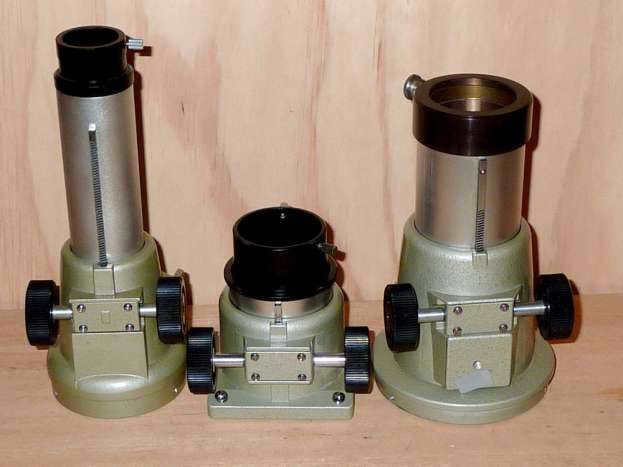
Rack focusers are available for both refractor and Newtonian reflector telescopes. The refractor model comes in two sizes: 1.25″ and 2″. The Newtonian reflector model is 2″ in size and is positioned in the center.
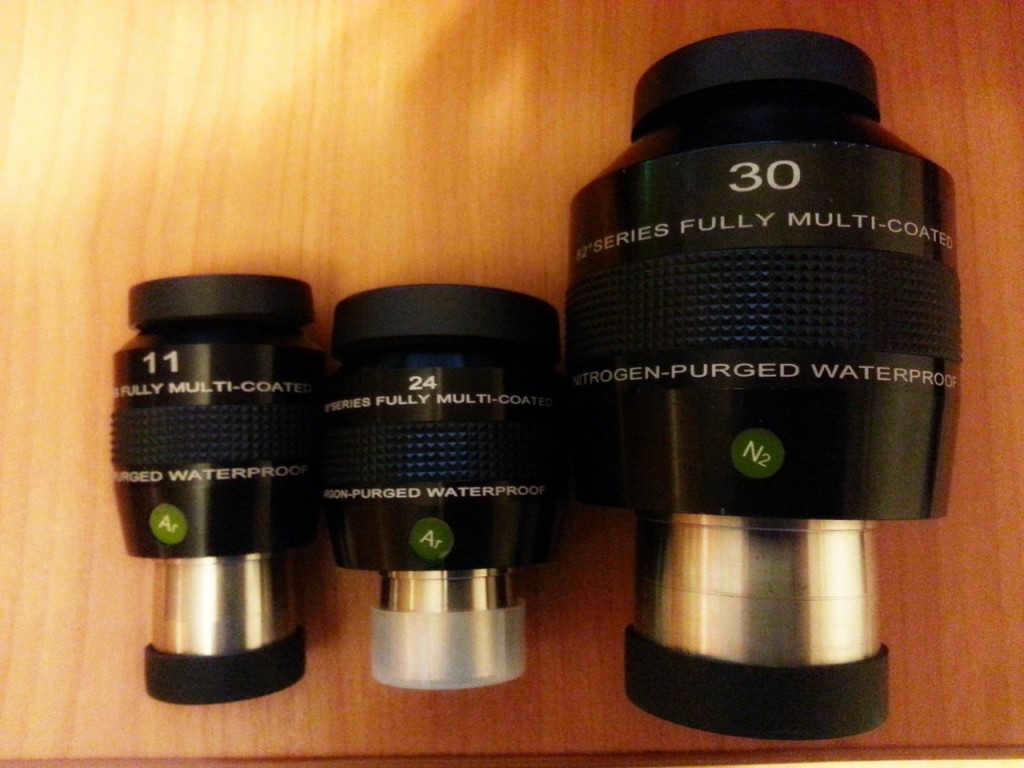

Eyepieces with different fitting diameters are available for telescopes, such as ES 11\82 1.25″, 24\68 1.25″, and 30\82 2″.
3. Field of View.
Furthermore, the eyepiece also affects the field of view of the telescope. There are various types of field of view to consider.
1) The angular size of the image observed through an eyepiece, also known as the aperture’s angular size, determines the field of view.
Manufacturers typically provide the field of view measurement, but there may be discrepancies between the stated and actual values. The field of view can range from 38 to 120 degrees for different eyepieces. The Plössl eyepieces, which are commonly used, typically offer a field of view of approximately 50 degrees. However, it’s important to note that the stated field of view may not always align with the actual field of view.
Eyepieces with a field of view ranging from 66 to 82 degrees are classified as wide-angle, while those with a range of 82 to 120 degrees are referred to as super-wide-angle. The field of view can be specified in the eyepiece’s characteristics or directly included in its name, such as the Explore Scientific 24 mm 68 degrees eyepiece.
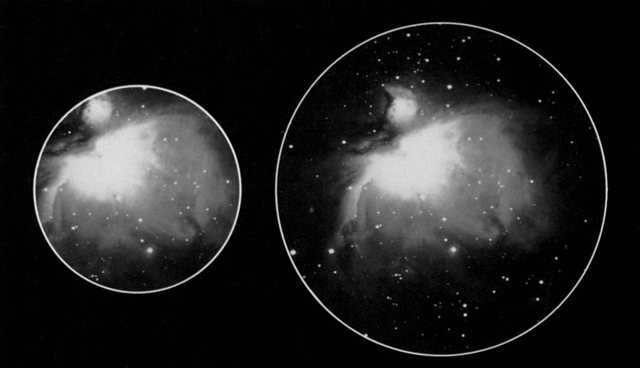
Observing the Orion Nebula through eyepieces with identical focal lengths but varying field of views.
2) The true field of view refers to the angular size of the sky visible through an eyepiece when used with any telescope and at the appropriate magnification.
To determine the true field of view of a telescope, divide the eyepiece’s field of view by the magnification.
For instance, if the eyepiece has a field of view of 40 degrees and the telescope’s magnification is 40x, the true field of view would be 40/40 = 1 degree (equivalent to 2 lunar angular diameters).
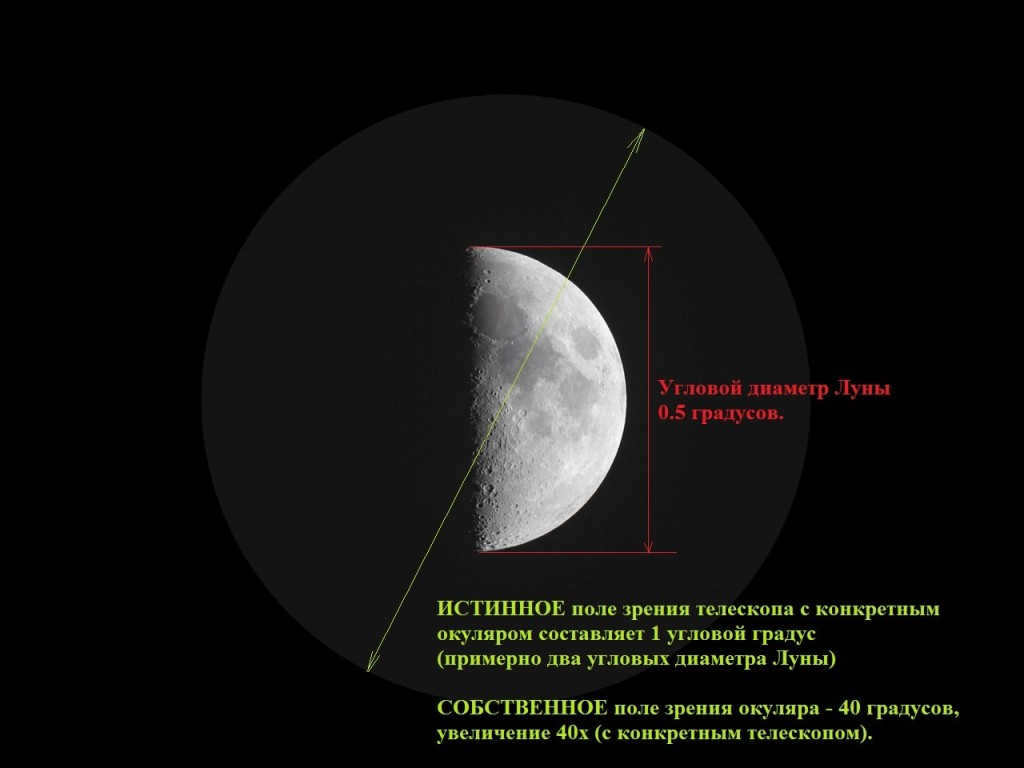
An approximate image of the Moon can be observed through a telescope that has a magnification of 40x and an eyepiece with a field of view of 40 degrees.
When using eyepieces with variable focal lengths (also known as zoom eyepieces), the field of view can also be adjusted. Generally, at the maximum focal length, the field of view is minimal (around 40 degrees), while at the minimum focal length it is maximized (ranging from 50 to 66 degrees). By adjusting the focal length of the eyepiece, one can observe the changing field of view.
4. Bulging of the student.
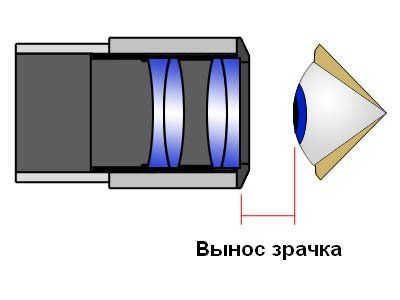
Another crucial factor that is often overlooked by beginners is pupil outreach. Pupil outreach refers to the distance between the eyepiece lens and the eye, at which the entire field of view of the eyepiece can be seen. If the pupil outreach is small (less than 10 mm), it can make observations uncomfortable. In such cases, you have to press your eye tightly against the eyepiece, which can result in your eyelashes smudging the lens. Additionally, the eye lens may fog up, and in cold weather, there is a risk of overcooling your eye. Ideally, a pupil protrusion of 15-18 mm is the most comfortable. This is especially important for individuals who wear glasses, as it helps with the correction of astigmatism.
The calculation of pupil protrusion for eyepieces in the Plessl/Kelner/Erfle system is typically done by multiplying the focal length of the eyepiece by 0.7. For example, a 20 mm eyepiece in this system would have a pupil protrusion of approximately 14 mm, while a 4 mm eyepiece would have a pupil protrusion of only 2.8 mm.
There are also short-focus eyepieces available with increased pupil relief, known as Long Eye Relief eyepieces. These eyepieces combine a long-focus design with a negative front component, similar to a Barlow lens. It’s worth noting that a Barlow lens can also slightly increase pupil relief.
5. Types of Eyecups
Most eyepieces come with a built-in eyecup, which serves as a protective device against excess light. Eyecups can be made of either soft materials like rubber or hard materials like rubber or plastic. Besides protecting the eye from light, eyecups also help center the eye, ensuring that the exit pupil is easily visible. However, not all eyepieces come with an eyecup, but it is possible to create one yourself if desired, using materials like soft thermal insulation for plumbing pipes.
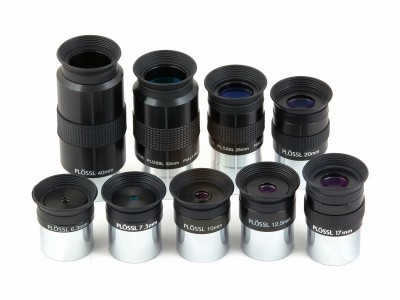
Telescope eyepieces equipped with a traditional rubber eyecup.
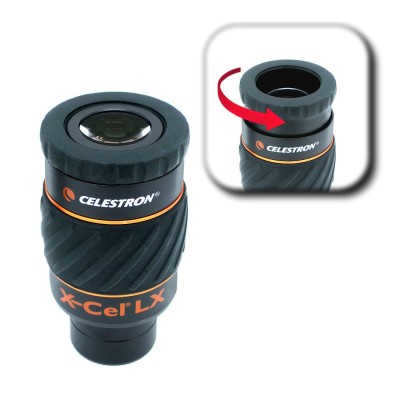
An eyepiece equipped with a sturdy twist-out eyecup
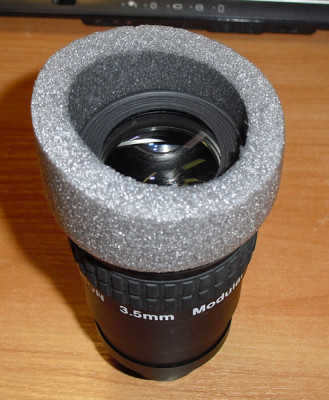
A homemade eyecup created from pipe heat insulation
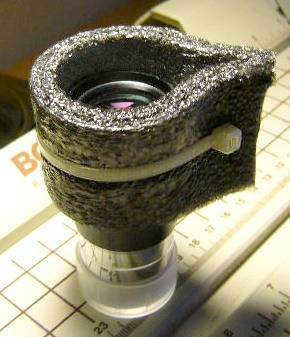
6. Optical configuration.
Over the span of 400 years since the telescope was first invented, there have been significant advancements in eyepiece technology. In the 20th century, with the introduction of electronic computing machines, new methods for calculating eyepieces were developed. Additionally, glass manufacturing technology has also progressed. Currently, there are more than several dozen known optical configurations.
Originally, a single lens was used as an eyepiece for collecting (known as Kepler’s eyepiece) or scattering (known as Galileo’s eyepiece). However, nowadays these types of eyepieces are rarely used, except in toy telescopes and theater binoculars. More advanced are the two-lens eyepieces called Huygens and Ramsden systems. They are still commonly used in affordable binoculars and microscopes. These eyepieces are usually marked with the letters “H” or “R” respectively (e.g., H20, R10).
Galileo and Kepler Eyepieces
Almost every budget telescope is equipped with a three-lens eyepiece from the Kelner system. This eyepiece consists of a single lens and an achromatic bond. The main advantage of the Kelner eyepiece is its affordability. Kelner eyepieces work well with telescopes that have smaller apertures. Kelner eyepieces are labeled with the letter “K” (e.g., K20).
Budget-friendly wide-angle eyepieces are primarily represented by the Erfle scheme. The Erfle scheme is a type of eyepiece that consists of five lenses and offers a field of view ranging from 60 to 90 degrees. One of the advantages of these eyepieces is their affordability and lightweight design. However, they may produce lower image quality in the field when used with telescopes that have a wider aperture, such as f/5 telescopes. Eyepieces utilizing the Erfle system are better suited for telescopes with a lower aperture. They can be a decent option for those looking to experiment with wide-angle eyepieces without breaking the bank. Personally, I began my stargazing journey with these eyepieces before eventually upgrading to higher quality wide-angle options. These eyepieces are often labeled as SWA, SWAN, UW, or sometimes UWA.
7. Enhancing Visibility.
In order to minimize lens glare, enhance light transmission, and improve image contrast, eyepiece lenses are coated with an ultra-thin film (“enhanced”). It is not advisable to use eyepieces that lack any form of enhancement, as this can negatively impact the viewing experience. Generally, the darker the glare from the eyepiece, the better the luminosity. The color of the enhancement can vary greatly – blue, violet, green, orange, or red (“ruby”). In high-quality eyepieces, the lens glare appears as a serene green or lilac hue.
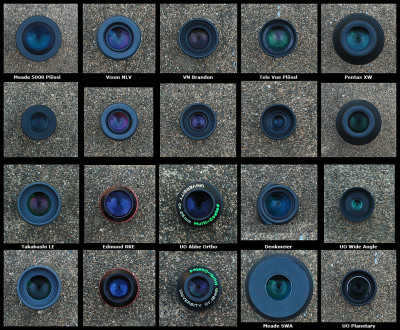
8. Manufacturer Brands.
The leading manufacturers of eyepieces are as follows:
Sky-Watcher
Celestron
Meade
Deepsky
REFINERY
Baader Planetarium
Long Perng
Orion
Levenhuk
William Optics
Explore Scientific
Nagler
Levenhuk, Orion, William Optics, Deepsky, Meade are not the actual manufacturers of the eyepieces. They simply purchase batches of eyepieces from other manufacturers such as Synta\Sky-Watcher, Long Perng, and UO, and rebrand them as their own. It is common for the same eyepiece to be packaged under different brands – for example, the Deepsky UWA 28 mm 82 degrees, William Optics UWAN 28 mm 82 degrees, and Levenhuk Ra UWA 28 mm 82 degrees, or the Deepsky Plano\Celestron X-Cel LX\Meade HD. Therefore, it is important to exercise caution when making a purchase!
The price range for eyepieces can vary greatly, ranging from $3-4 to $1200. The cost is determined by various factors, including the specific features and the brand of the eyepiece.
Essential guidelines and suggestions for selecting an eyepiece.
Firstly, it is not recommended to immediately discard the original eyepieces of your newly purchased telescope and rush to buy expensive replacements. The included Kelner\Plossl eyepieces with focal lengths of 25, 10, and 6.3 mm are actually quite good. It is advisable to begin observing with these native eyepieces first, as they are more than sufficient for getting acquainted with the night sky. Instead of using the included Barlow lenses, which can actually decrease image quality, it is better to invest in a separate high-quality Barlow lens.
If you do decide to purchase additional eyepieces, consider factors such as focal length, field of view, and price. If you are on a tight budget, ordinary Plossl eyepieces with focal lengths of 10-7.5 mm are a good option. For observing planets, these eyepieces can be used in combination with a good Barlow lens.
If you are looking for a wide-angle eyepiece, here’s a general guideline: for telescopes with non-aperture (f/7-f/15) ratios, you can opt for affordable wide-angle eyepieces such as Deepsky WA, SWA or UW, which offer a field of view of 60-80 degrees. However, if you have a telescope with a light-aperture (f/4-f/5) ratio, it is recommended to invest in high-quality wide-angle eyepieces like Explore Scientific (68-82 degrees), Televue Nagler, or Televue Panoptic. Additionally, for Newtonian telescopes, a coma corrector like GSO or Televue can be beneficial.
If you come across any errors, please select the text and press Ctrl+Enter.
The significance of eyepieces in the “optical path” of a telescope is frequently undervalued. Even if an image is created by an exceptional lens in optimal atmospheric conditions, it can be ruined by the utilization of a low-quality eyepiece. Furthermore, there exist whole lineages of eyepieces that vary in construction quality and price, mechanical precision, lens polishing and luminescence, and most notably – in the optical design.
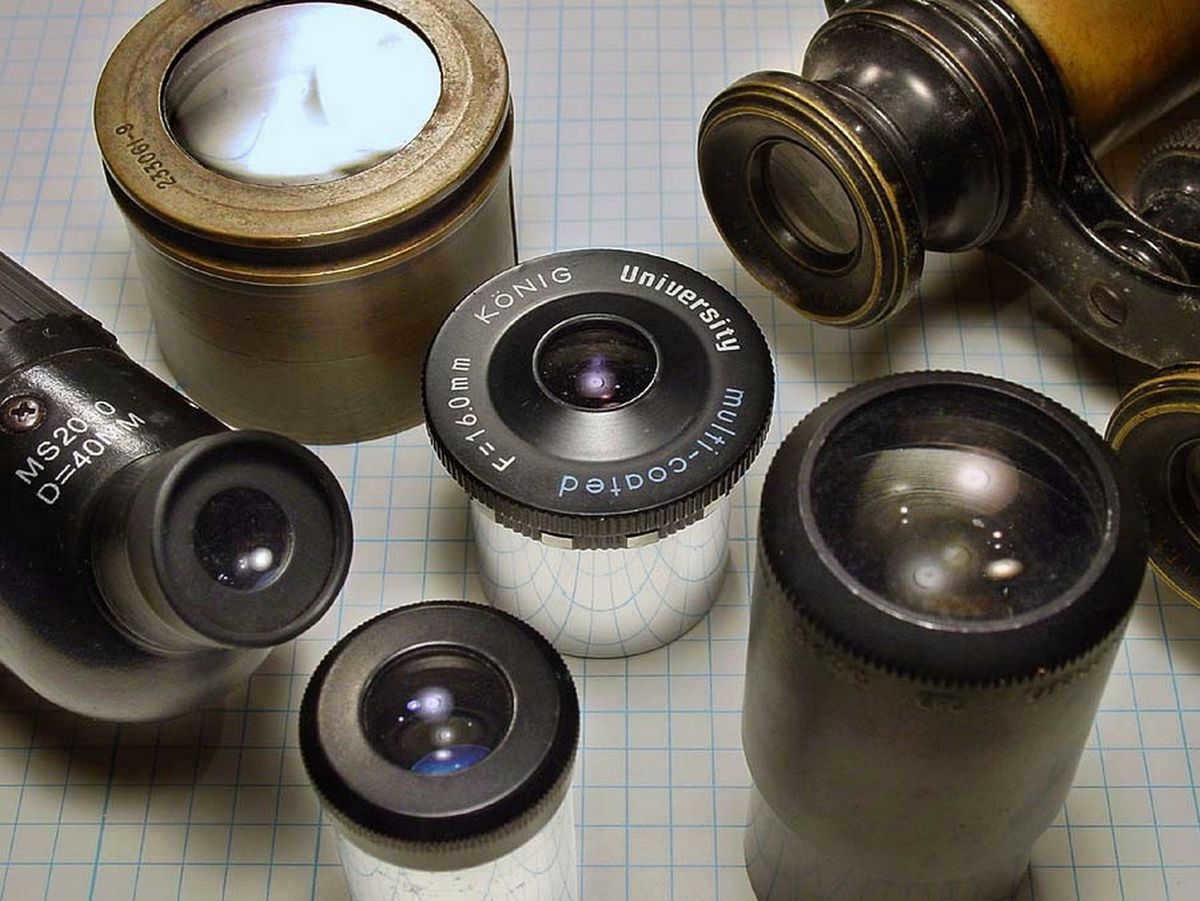
With the advancement of optics, there has been the emergence of new and more advanced optical designs for both telescopes and eyepieces. Nowadays, many eyepieces have reached a level of optical perfection that exceeds the expectations of astronomy enthusiasts, bringing them joy once again. However, simply selecting the most perfect and modern optical scheme for an eyepiece is not always sufficient. In certain cases, eyepieces with classical schemes perform much better, provided they are of high quality. In summary, in order to achieve excellent observation results, amateur astronomers must understand the various types of eyepiece optics and determine which systems are best suited for their specific tasks.
Telescope eyepiece
The device used for viewing through a telescope is called an eyepiece, which is composed of two main components – an optical block and a mechanical unit. The optical block comprises a series of lenses that form a specific optical system, which we will discuss in more detail later. The mechanical unit, on the other hand, is the housing for the eyepiece that houses the optical block and features a standard 1.25″ or 2″ diameter seating “skirt”.
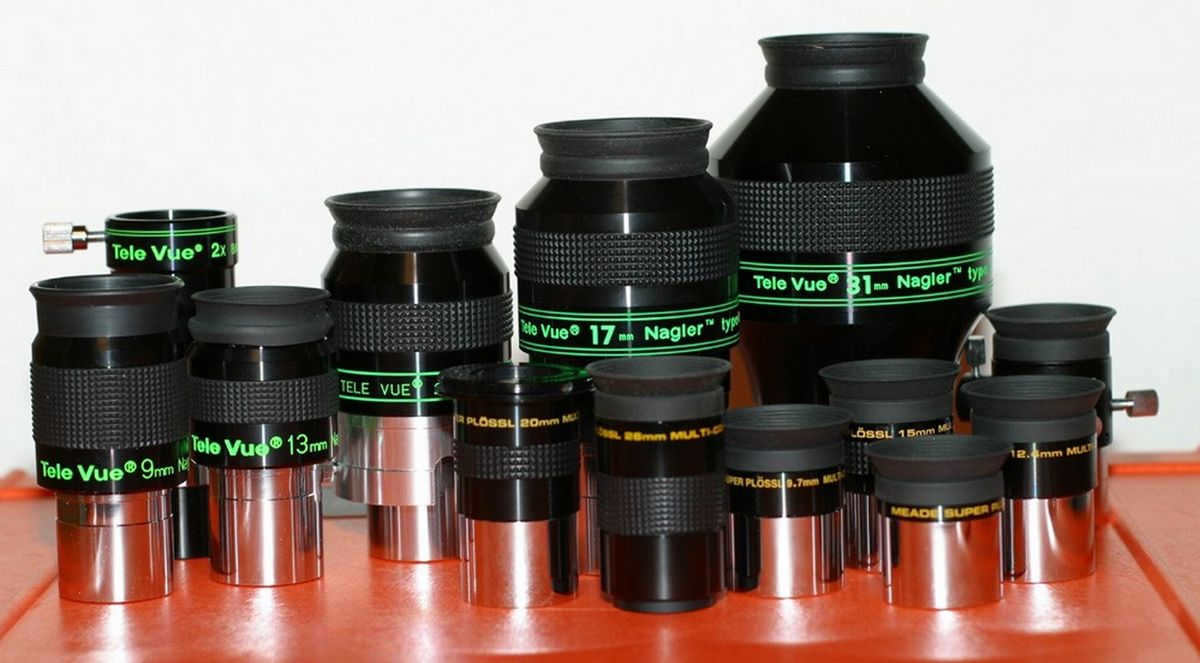
The interior of the eyepiece skirt is often finely threaded in order to attach light filters. Adjacent to the eye lens is a small rubber ring known as the eyecup. Its purpose is to shield the observer’s eye from unwanted rays.
Therefore, once the eyepiece is inserted into the eyepiece assembly of the telescope, it is introduced into the beam of light gathered by the lens. In most optical designs, there is a field diaphragm positioned in the focal plane. Typically, the field diaphragm determines the eyepiece’s field of view, allowing for a high-quality image within this field while cutting off the peripheral areas that may contain distortions.
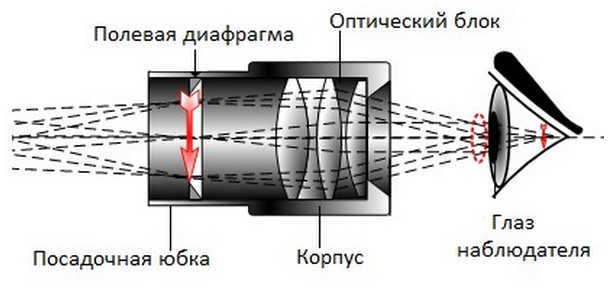
It is important to approach the concept of field of view with caution. Many eyepiece manufacturers, such as the popular Plossl, often list a field of view of 50-52° in their specifications. However, in reality, these eyepieces typically provide a true field of view of about 45°. This means that the manufacturer is indicating the calculated field of view of the optical system, which is approximately 50°, without specifying the actual usable field determined by the field diaphragm. While not all manufacturers engage in this practice, some manipulation of theoretical concepts in optics is fairly common, with the manufacturer relying on uninformed consumers.
Crucial factors
Prior to delving into an in-depth examination of the optical designs of eyepieces, let’s take a look at the most crucial factors that determine the optical characteristics of the eyepiece.
Effective focal length
When it comes to selecting an eyepiece, our main consideration is its focal length, as this determines the level of magnification we can achieve. However, caution must be exercised when aiming for maximum magnifications, as using a high-quality eyepiece with a focal length that is too short for the telescope can result in a subpar image. Generally, it is recommended to use a magnification of approximately 2 times the diameter of the telescope’s lens in millimeters for refractor telescopes, and 1.6 times for reflector telescopes, under optimal observing conditions. While this guideline is based on empirical evidence and may vary slightly depending on factors such as atmospheric stability and optical quality, it serves as a reliable reference in most situations.
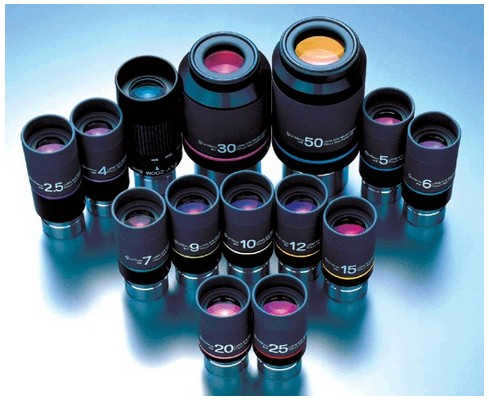
Expanding the Field of View
Everyone desires to maximize their field of view. This is especially important when observing long objects such as diffuse nebulae, star clusters, and large galaxies. It can be challenging to switch from a broad perspective to a narrow one, as it feels like going from a spacious window to a tiny keyhole. Some eyepieces create the sensation of peering through a small hole in the sky, while others, like a high-quality wide-angle eyepiece, provide a view akin to looking through a porthole! However, even wide-angle eyepieces have their drawbacks due to the complexity of their optical design.
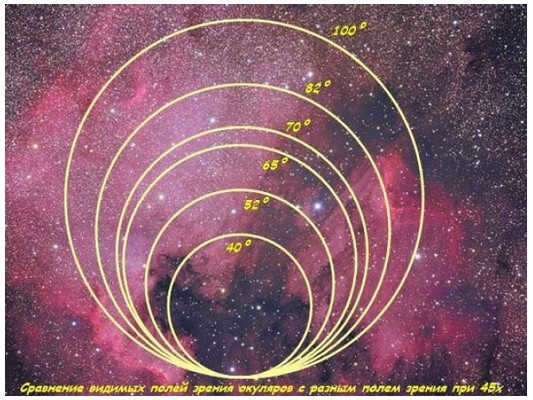
Engaging with Students
The measurement of the gap between the eyepiece lens and the pupil of the viewer is referred to as pupil outreach. It is essential to consider this value. If the pupil outreach is too small, typically around 4-6mm, the lens will inevitably touch the eye, causing discomfort during observation. Conversely, if the outreach is too large, it will be challenging to maintain a fixed distance between the eye and the eyepiece. Additionally, the incidence of stray rays on the eye is significant. In most cases, a pupil outreach of 15-20mm offers the most comfortable experience.
Various Types of Optical Systems
The primary function of the telescope eyepiece is to enlarge the image produced by the objective lens in the focal plane of the telescope. Initially, this task may seem straightforward. It may appear that using a regular magnifying glass with an appropriate focal length would suffice. However, in reality, the situation becomes significantly more complex. A single lens would possess numerous aberrations, which would have a highly detrimental effect on the image. In the most basic scenario, a system consisting of several lenses should be employed.
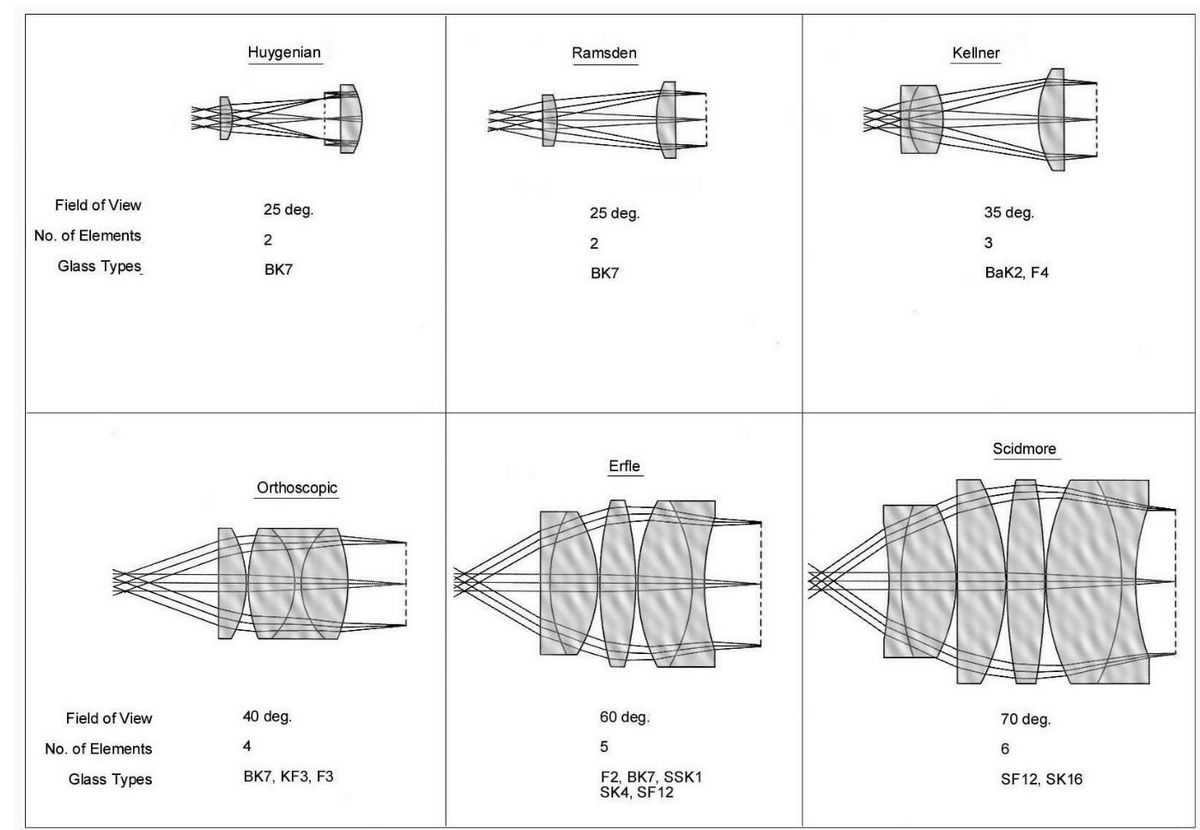
The Ramsden eyepiece. is an eyepiece with multiple lenses that has been in use for a long time and is still available today. It is made up of two flat-convex lenses that effectively correct spherical and chromatic aberration. While it only provides minimal correction for astigmatism and has a small pupil outreach, it is still a popular choice. This type of eyepiece typically offers a field of view between 35-40°. It is commonly included as part of the eyepiece set in affordable telescope models.


An Orthoscopic eyepiece, also known as an Orthoscopic, is composed of four lenses, three of which are fused together. It is particularly well-suited for magnifications at both high and medium levels. This is due to its excellent exit pupil, effective chromatism correction, and exceptional image clarity. With a field of view of approximately 45°, it is perfect for in-depth examinations of celestial bodies like the Moon and planets, as well as for separating double stars. It is an ideal choice for any application that requires high magnification and reliable eyepiece performance.


The Erfle eyepiece (also known as Erfle) is often referred to as WA (Wide Angle) or SWA (Super Wide Angle) in modern nomenclature. These eyepieces are specifically designed to provide a larger field of view, typically around 60-70°, and are constructed with five or six lenses. They are particularly well-suited for stargazers who are interested in observing faint and extended objects such as galaxies, nebulae, and comets. However, it’s worth noting that as magnification increases, image quality may deteriorate noticeably at the edges. To mitigate this issue, it is crucial to use high-quality and multi-layer lenses in these eyepieces, as the presence of multiple lenses can lead to light loss and increased glare.


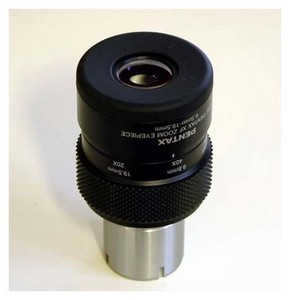
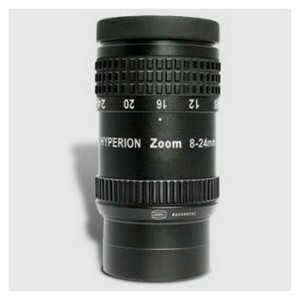
Aside from the eyepieces, it would be wise to also consider the Barlow lens. A Barlow lens typically consists of two or more lenses that act as a negative optical component. When light collected by a telescope passes through this system, the cone of rays narrows in relation to the optical axis. As a result, we achieve a magnification of the telescope’s equivalent focus by a factor equal to the lens’ magnification. Nowadays, Barlow lenses come in various designs, versions, and optical configurations, catering to both visual observations and astrophotography. The key benefit of investing in a Barlow lens is that with just one accessory, you can double the magnification of all your eyepieces, effectively expanding the range of magnification capabilities for your telescope.
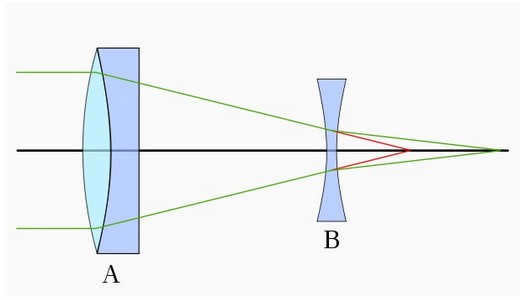
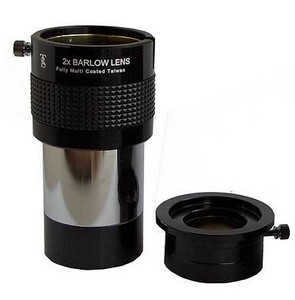
What is the process of putting together an eyepiece collection?
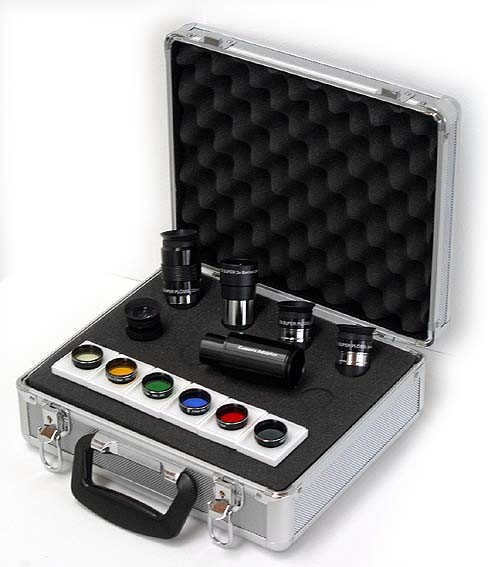
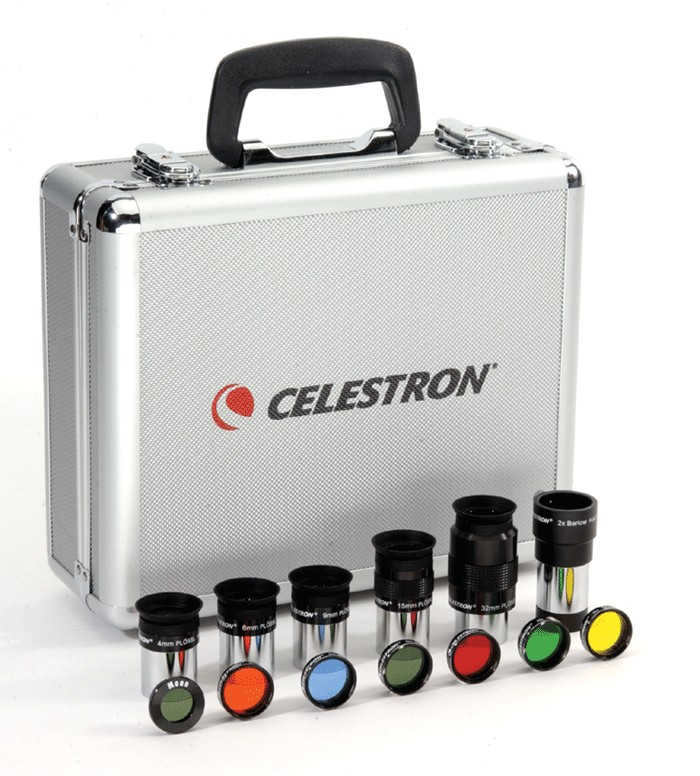
At the end of the day, your budget plays a significant role. As mentioned earlier, the Plössl eyepieces stand out in terms of cost and versatility, which is why they have become so popular. Numerous manufacturers offer fantastic collections that include multiple Plössl eyepieces, a Barlow lens, and a set of light filters. This comprehensive option covers the entire range of magnification. It might be worth exploring such a collection or creating your own by selecting your favorite eyepieces.
In order to assemble a convenient and highly effective set of eyepieces, it is important to determine the magnifications required for observations. Below, based on simple formulas derived from the experience of amateur astronomers, we suggest selecting a set of basic magnifications. The letter “D” represents the diameter of the objective lens of your telescope (in mm). For our calculations, we will use a common lens size among amateur astronomers – 150mm.
The minimum magnification of the telescope, which is typically necessary for work, can be calculated as D/6. This eyepiece is commonly used for pointing the telescope and general observation and search tasks. For a telescope with a 150mm lens, the minimum magnification would be approximately 25x.
A D/2 or medium magnification telescope is necessary for observing compact dip-sky objects like planetary nebulae or globular star clusters. It is also suitable for lunar observations. With a 150mm aperture, the average magnification is 75x.
A 1D magnification, which is equal to the diameter of the lens, is a balance between medium and high magnification. It can be used for both types of observations. With this magnification, it is possible to separate globular star clusters and observe details of nebulae and galaxies, as well as observe planets. For a 150mm aperture, 1D is equivalent to 150x magnification.
Suppose we have performed these calculations for a Newtonian telescope with a 150mm aperture and a 750mm focal length. The results of our calculations suggest that the telescope would be adequate:

Undoubtedly, we have presented illustrations of just the most essential assortment of magnifications for a wide range of observations. If you have a particular interest in a specific area, you have the possibility to greatly expand your collection of eyepieces. Keep in mind that the aforementioned magnification set can be achieved not only by acquiring an eyepiece for each individual value, but also by combining your existing collection with a Barlow lens. For instance, you can assemble the following assortment:
The combination of a 25mm and 10mm eyepiece, along with a 2x Barlow lens, will grant you a total of four distinct magnifications, which are equivalent to 12.5mm and 5mm in addition to the aforementioned eyepieces;
On the other hand, a set consisting of a 32mm, 12mm, and 7mm eyepiece, combined with a 2x Barlow lens, will provide you with a total of six magnifications, three of which are 16mm, 6mm, and 3.5mm.
Undoubtedly, it is imperative to create such combinations that enable the attainment of optimal magnifications while observing, rather than confining oneself to only the aforementioned four formulas. Ideally, it would be beneficial to incorporate intermediate values such as D/4, D/1.5, etc., thereby ensuring the constant availability of the most efficient magnification for every individual object.
When selecting your eyepiece collection, it is crucial to make a wise choice. Instead of settling for three eyepieces that are of low quality or simply average, it is better to invest in a single eyepiece that can provide you with the joy of observation for many years, even if it carries the same price tag as three inexpensive ones. Additionally, it is important to keep in mind that as you purchase your first telescope and delve deeper into astronomy, you may eventually need to upgrade to a more powerful and expensive telescope. In such cases, you can always sell your old telescope. However, a high-quality set of eyepieces can continue to serve you well for a significant period of time.
Essentially, the fundamental parameters of an eyepiece include:
1. the focal length
2. the fitting diameter (ranging from 1.25 to 3 inches)
3. the field of view (ranging from 38 to 120 degrees)
4. the pupil protrusion
5. the type of eyecup
6. the optical scheme
7. the luminescence
8. the brand (manufacturer)
When looking through the eyepiece, we observe the image that is created by the telescope lens in the focal plane. To illustrate this concept, let’s envision two magnifying glasses: the larger one acting as the objective and the smaller one acting as the eyepiece.
When beginners first purchase a telescope, they often make the mistake of immediately setting the magnification to its maximum. They are then surprised when all they see is darkness. It’s important to understand that different celestial objects require different levels of magnification. Planets, the Moon, and double stars can be observed with high magnification, while galaxies, nebulae, and clusters are best observed with a lower or medium magnification. It’s essential to remember that the higher the magnification, the dimmer the image becomes and the worse the contrast. If you try to observe planets with excessive magnification, all you’ll see is a blurry, faint spot.
Focal length
The focal length is a crucial parameter when it comes to eyepieces. It is typically specified in the eyepiece’s name or labeling (e.g., Explore Scientific 11 mm 82 degrees). The concept here is straightforward: the shorter the focal length of the eyepiece, the higher the magnification of the telescope. To calculate the telescope’s magnification, you can divide the telescope’s focal length by the eyepiece’s focal length. For instance, if the telescope’s focal length is 1000mm and the eyepiece’s focal length is 10mm, the magnification will be 100x. The focal length of eyepieces can range from 56mm to 2mm.
The maximum magnification of a telescope depends on its objective lens diameter and is approximately 1.5 times to 2 times the diameter of the objective lens (D). For example, a 150mm telescope with high-quality optics will have a maximum magnification of about 300x.
There is a formula to calculate the minimum magnification of a telescope, which is D\7, where D represents the diameter of the lens in mm. For instance, a telescope with a 150mm lens has a minimum magnification of 21x. This minimum magnification is also known as equal magnification. It is not practical to use a lower magnification, such as 20x, because the beam of light from the eyepiece would be larger than the observer’s pupil, causing the light to pass by the eye. However, if a wider field of view is necessary, it is acceptable to use exit pupils larger than 7mm. The image brightness will remain the same as with equal pupil magnification, but the central portion of the lens will be the only part that is effectively utilized.
Different celestial objects require different levels of magnification to observe:
Typically, a combination of two or three eyepieces with varying focal lengths, along with a reliable Barlow lens, is sufficient for observing most types of objects in space.
Eyepieces are available in two types: fixed focal lengths and variable focal lengths, also known as zoom eyepieces. Zoom eyepieces typically have a focal length range of up to three times (8-24 mm, 7-21 mm, 3-6 mm, 2-4 mm).
Seating Diameter Explained
When it comes to telescopes, the seating diameter of the eyepiece is an important factor to consider. The eyepiece is inserted into a special fixture called a focuser, which determines the seating diameter. In the world of amateur telescopes, the most common seating diameters for eyepieces are 1.25 inches (1.25″) and 2 inches (2″). There are also less common options like 0.965 inches (0.965″) and even rarer 3 inches (3″).
If your telescope has a 1.25″ focuser, you can use eyepieces with a seating diameter of 1.25″. If you have a 2″ focuser, you have the flexibility to use both 2″ eyepieces and 1.25″ eyepieces with a special adapter. However, if you have a 3″ focuser, there are not many eyepieces available, except for the famous Explore Scientific 30mm 100 degree eyepiece.
The 0.965″ focuser is typically found on the simplest telescopes with an aperture of up to 50mm.
2″ eyepieces offer the advantage of capturing a wider field of view compared to eyepieces with a 1.25″ fit, while maintaining the same focal length. For instance, a 30mm eyepiece with a 1.25″ fit has a maximum field of view that is 1.6 times smaller than what can be achieved with a 30mm eyepiece with a 2″ fit.
Field of View.
In addition, the field of view provided by the telescope is also influenced by the type of eyepiece used. There are various types of field of view available.
1) The eyepiece’s field of view refers to the angular size of the image that is visible through it (the angular size of the aperture).
Manufacturers typically provide the field of view measurement, but in some cases, the actual value may differ. The field of view can range from 38 to 120 degrees for different eyepieces. The most common type, Plössl eyepieces, typically have a field of view of around 50 degrees. However, it’s important to note that the stated field of view may not always match the actual field of view.
Eyepieces with a field of view between 66 and 82 degrees are known as wide-angle, while those between 82 and 120 degrees are referred to as super-wide-angle. The field of view is usually specified in the eyepiece’s characteristics or directly in its name, such as the Explore Scientific 24mm 68-degree eyepiece.
Zoom eyepieces, which have adjustable focal lengths, also offer a varying field of view. Generally, the field of view is minimized (around 40 degrees) when the focal length is at its maximum, and maximized (50-66 degrees) when the focal length is at its minimum. By adjusting the focal length of the eyepiece, you can observe the changes in the field of view.
Pupil Protrusion
Another parameter that beginners often overlook is pupil protrusion. Pupil protrusion refers to the distance from the lens of the eye to the eyepiece, at which the entire field of view is visible. If the pupil protrusion is small (less than 10 mm), observations can become uncomfortable. This is because you have to press your eye too tightly against the eyepiece, which can lead to dirtying the lens with eyelashes, fogging of the eye lens, and even overcooling of the eye in cold weather. The most comfortable pupil protrusion is between 15-18 mm. This is especially important for individuals who wear glasses, as it allows for proper correction of astigmatism.
An error commonly made by beginners is to apply excessive pressure to the eye lens, even when the pupil dilation is greater than 15 mm. In such cases, a portion of the field of vision is lost. It is important to find a comfortable position for the eye and avoid shifting it while observing from the axis.
Typically, with eyepieces of the Plessl/Kelner/Erfle system, the pupil dilation can be calculated using the formula 0.7*F, where F is the focal length of the eyepiece. For example, a 20 mm eyepiece from one of these systems would have a pupil dilation of approximately 14 mm, while a 4 mm eyepiece would have a pupil dilation of only 2.8 mm.
There are eyepieces with a short focal length that have increased pupil relief, which is known as Long Eye Relief. These eyepieces are essentially a combination of a long-focus eyepiece and a negative front component, similar to a Barlow lens. By the way, the Barlow lens also slightly increases the pupil outreach.
Eyecup type
Most eyepieces come with a special light-protective device called an eyecup. The eyecup can be made of soft materials like rubber or rubber-like materials, or it can be made of hard rubber or plastic. In addition to protecting against light, the eyecup also helps center the eye so that it doesn’t have to align with the exit pupil. Some eyepieces may not come with an eyecup, but you can easily make one yourself using soft thermal insulation for sanitary pipes.
Over the past four centuries, eyepieces have undergone significant transformations since the creation of the telescope. In the 20th century, with the introduction of electronic computers, new methods for calculating eyepieces emerged. Furthermore, advancements in glass manufacturing technology have also played a role. At present, there are over several dozen known eyepiece designs.
Originally, eyepieces utilized a single lens for collecting (known as Kepler’s eyepiece) or scattering (known as Galileo’s eyepiece). Nowadays, these eyepiece designs are rarely used, except in toy telescopes and theater binoculars. More advanced are the two-lens eyepieces of the Huygens and Ramsden systems. These are still employed in affordable binoculars and microscopes. They are typically denoted by the letters “H” or “R” respectively (H20, R10).
Most budget telescopes come with a Kelner system eyepiece that has three lenses. This eyepiece is made up of a single lens and achromatic bonding. The main advantage of this eyepiece is its affordable price. Eyepieces of the Köln system are compatible with telescopes that have a smaller aperture. Köln eyepieces are identified with the letter “K” (e.g., K20).
The next type of eyepiece is the Plössl eyepiece. The optical design of this eyepiece consists of four lenses – two lenses bonded together facing each other with positive lenses. This is why it is also known as a symmetrical eyepiece. The marking for this type of eyepiece is “PL” (PL 12.5).
Budget-friendly wide-angle eyepieces are primarily represented by the Erfle design. The Erfle design consists of five lenses and offers a field of view ranging from 60 to 90 degrees. One of the advantages of these eyepieces is their affordability and lightweight construction. However, they do have a drawback when used with fast telescopes (f/5) as they may result in a poor field image quality. The Erfle eyepieces are best suited for telescopes with a low aperture. They serve as a decent option for those who want to experiment with wide-angle eyepieces without breaking the bank. Personally, I started my own journey with these eyepieces and later upgraded to higher quality wide-angle options. These eyepieces are often labeled as SWA, SWAN, UW, and sometimes UWA.
Enhancing Visibility
To enhance visibility, increase light transmission, and improve image contrast, the lenses of eyepieces are coated with an ultra-thin film (“illuminated”). The most basic and affordable eyepieces may not have any illumination at all, which is not ideal. Generally, the darker the glare from the eyepiece, the better the luminosity. The color of the illumination can vary greatly, including blue, violet, green, orange, and red (“ruby”). In high-quality eyepieces, the glare from the lenses appears as a serene green or lilac hue.
The primary manufacturers of eyepieces are:
- Sky-Watcher
- Celestron
- Meade
- Deepsky
- REFINERY
- Baader Planetarium
- Long Perng
- Orion
- Levenhuk
- William Optics
- Explore Scientific
- Nagler
Levenhuk, Orion, William Optics, Deepsky, Meade are not manufacturing companies. They simply purchase a batch of eyepieces from other manufacturers (Synta/Sky-Watcher, Long Perng, UO) and sell them under their own branding. Often, the same eyepiece can be found in different packaging under different brands. For example, the Deepsky UWA 28 mm 82 degrees can also be sold as the William Optics UWAN 28 mm 82 degrees or the Levenhuk Ra UWA 28 mm 82 degrees. The same applies to the Deepsky Plano/Celestron X-Cel LX/Meade HD. Therefore, it is important to exercise caution when purchasing.
The price range for eyepieces can vary significantly, ranging from $3-4 to $1200. The cost depends on the specific characteristics and brand.
Tips and recommendations for choosing the right eyepiece
First and foremost, it is not necessary to immediately discard the eyepieces that come with your telescope and rush to buy expensive ones. The included Kölner/Plessles eyepieces with focal lengths of 25, 10, and 6.3 mm are actually quite good. It is recommended to start observing with these native eyepieces as they are more than sufficient for familiarizing yourself with the night sky. On the other hand, it is advised not to use the included Barlow lenses as they can degrade the image quality. Instead, it is advisable to invest in a high-quality Barlow lens separately.
If you decide to purchase additional eyepieces, consider the focal length, field of view, and price. If you are on a tight budget, ordinary Plessls with focal lengths of up to 10-7.5 mm are a good choice. For observing planets, use these eyepieces in combination with a good Barlow lens.
There is a general principle: the higher the brightness of the telescope, the more demanding the requirements for the quality of the eyepiece, specifically the level of correction of its own aberrations (distortions) of the eyepiece. For instance, on a light-gathering telescope of the Newtonian system (with a focal ratio of f/5), eyepieces with the same focal length but different optical designs will provide the same magnification but varying image quality. Conversely, on a non-aperture telescope (such as a Maksutov-Cassegrain), both a basic and a more advanced eyepiece will yield similar results.
If you are in need of a wide-angle eyepiece, the general guideline is as follows: for telescopes with non-aperture sizes ranging from f/7 to f/15, it is possible to use affordable wide-angle eyepieces such as Deepsky WA, SWA, or UW, which offer a field of view of 60-80 degrees. However, if your telescope has a faster aperture (ranging from f/4 to f/5), it is recommended to invest in higher quality wide-angle eyepieces such as the Explore Scientific series with field of views ranging from 68 to 82 degrees, or the Televue Nagler and Televue Panoptic models. In the case of Newtonian telescopes, a coma corrector such as the GSO or Televue is also recommended.
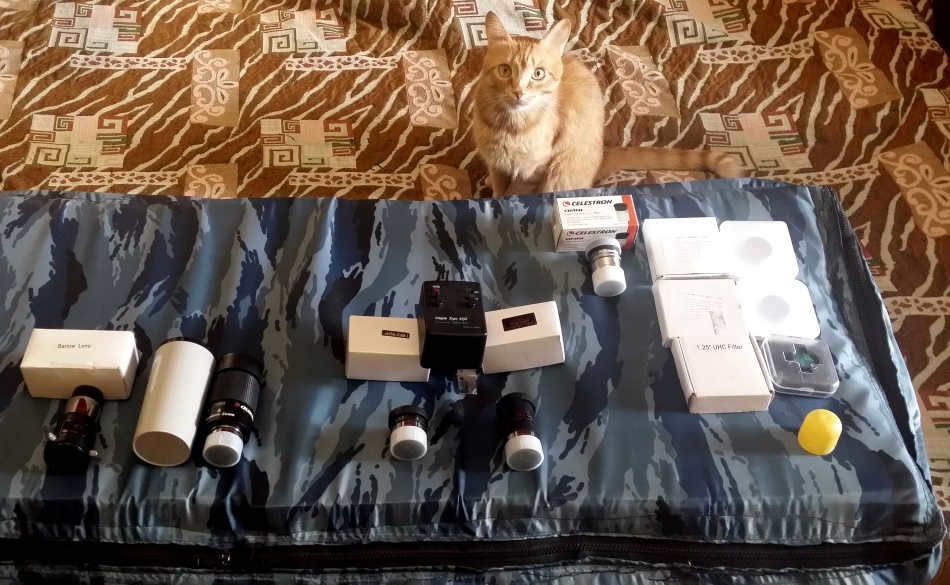

If you have a passion for astronomy and recently acquired a telescope, you may be considering different accessories to enhance your observations. This article focuses on the topic of upgrading your telescope with eyepieces, light filters, and other helpful accessories.
Within the amateur astronomy community, the subject of eyepieces and additional equipment is a highly debated topic. In this article, I will share my personal experience from two years of casually pursuing amateur visual astronomy. If you strongly disagree with the information presented here or if you have heard conflicting opinions, I kindly ask you to approach it with a sense of calmness and understanding.
Eyepieces
Eyepieces are optical components commonly used in telescopes and microscopes. They are designed to magnify the image formed by the objective lens or mirror so that it can be viewed by the observer. Eyepieces come in a variety of designs, including simple lenses, compound lenses, and even digital camera attachments. They are an essential part of any optical instrument and can greatly enhance the viewing experience. Whether you are a professional astronomer or just a hobbyist, having a high-quality eyepiece can make all the difference in your observations. So, when choosing an eyepiece, it is important to consider factors such as magnification, field of view, eye relief, and overall optical quality. With the right eyepiece, you can explore the wonders of the universe or discover the intricacies of the microscopic world in stunning detail.
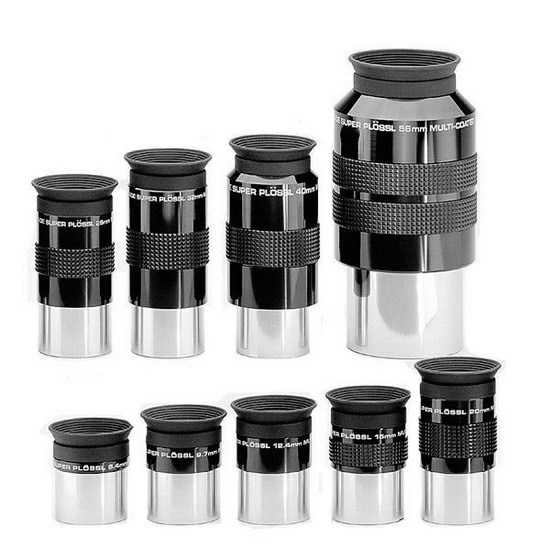
Some background information
Eyepieces, much like telescopes, have come a long way from their early days of being primitive devices that produced distorted images. Nowadays, they have evolved into advanced optical systems with anti-reflective coatings and computer modeling techniques being used during their development. Considering the various optical designs available for eyepieces would be pointless, as there are countless complex designs, each company having their own unique ones. Instead, it is more important to focus on the key properties of eyepieces:
The focal length determines the final magnification of the telescope when the eyepiece is attached. To calculate the magnification, divide the telescope’s focal length by the eyepiece’s focal length. For instance, a telescope with a focal length of 900 mm and an installed eyepiece of 24 mm will provide a magnification of 900/24 = 37.5x. Eyepieces ranging from 4 to 30 mm are commonly available, while eyepieces measuring 2-3 mm or larger than 30 mm are less common. Eyepieces with extreme focal lengths tend to be more expensive, complex, and may have their own drawbacks.
The field of view determines the size of the visible area in the eyepiece and how objects will appear within it. Typically, the field of view falls within the range of 40-60 degrees. A larger field of view is generally preferred.
The eye relief refers to how close your eye needs to be to the eyepiece. If you wear glasses, you will need an eyepiece with an eye relief of 12-20 mm. Eyepieces with very short eye relief may not be comfortable for individuals without glasses either.
The barrel diameter. There are two standard sizes for eyepiece barrels – 1.25″ and 2″. The 2″ focusers are superior and are typically found on more expensive telescopes. Some eyepieces come with adapters for both barrel diameters.
The weight. The weight of the eyepiece affects the load on the mount and its drive. The heaviest eyepieces weigh around half a pound.
By utilizing the Barlow lens, it is possible to double the number of available working focal lengths of eyepieces. The Barlow lens, also known as a scattering lens, is positioned in front of the eyepiece, effectively reducing its focal length, often by half (although there are also lenses with 3x magnification).
The Appearance of Objects in the Eyepiece
To easily visualize how objects will appear in an eyepiece with specific parameters, the “Eyepieces” plugin for Stellarium can be used. This plugin is included with the software and can be enabled in the settings.
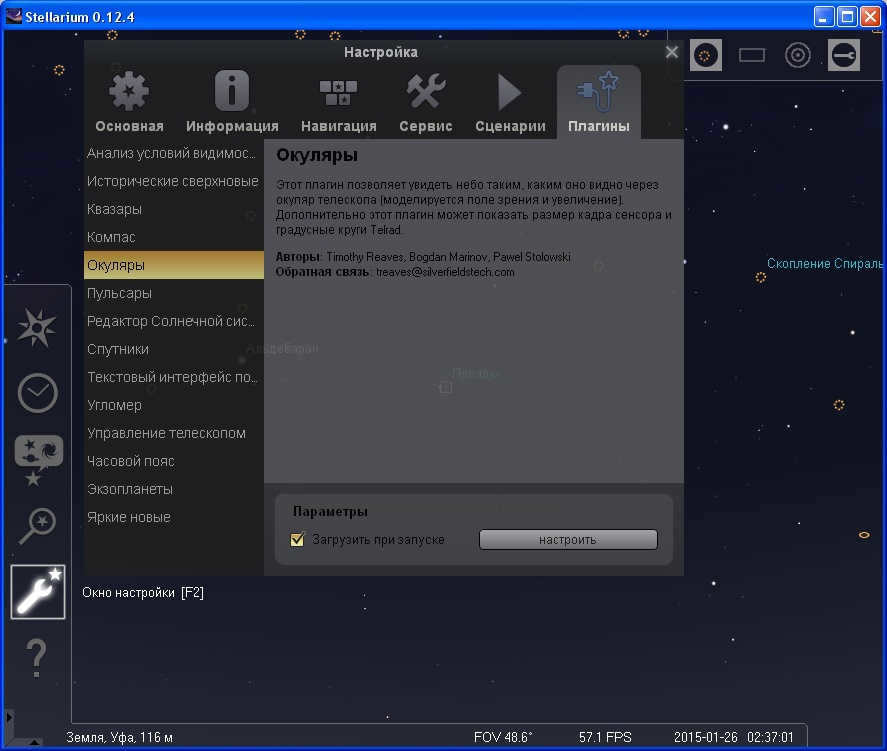
Let’s observe how the object’s visibility is influenced by the field of view of the eyepiece, using the Pleiades as an example under low magnification. In this case, we have a telescope with a focal length of 900 mm, and all eyepieces have a focal length of 20 mm. The field of view varies in increments of 20 degrees – 40, 60, 80, and 100 degrees. It is important to note that Stellarium presents objects in a more captivating manner than what can be observed through the telescope. Therefore, the stunning nebulae depicted in Stellarium may not be as visually impressive when viewed in reality.
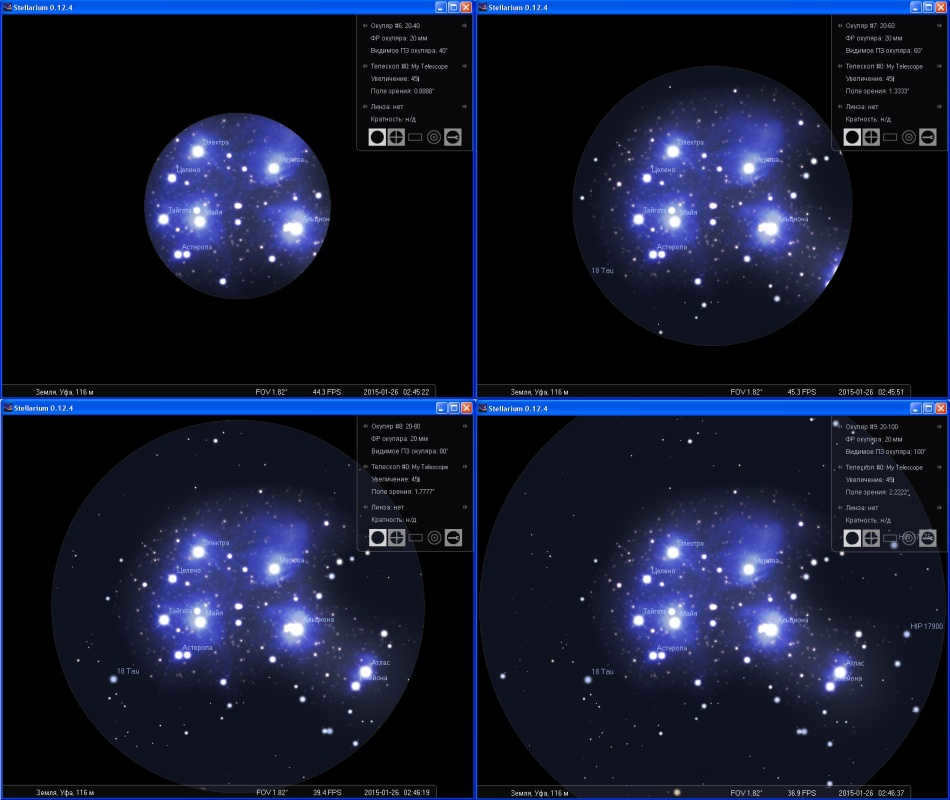
In order to observe the Pleiades, it is important to understand how the focal length of the eyepiece can affect the visibility of the object. Let’s take a telescope with a focal length of 900 mm and eyepieces that all have a field of view of 60 degrees. We will change the focal length of the eyepiece in increments of 5 mm, starting from 30 mm and going down to 5 mm.
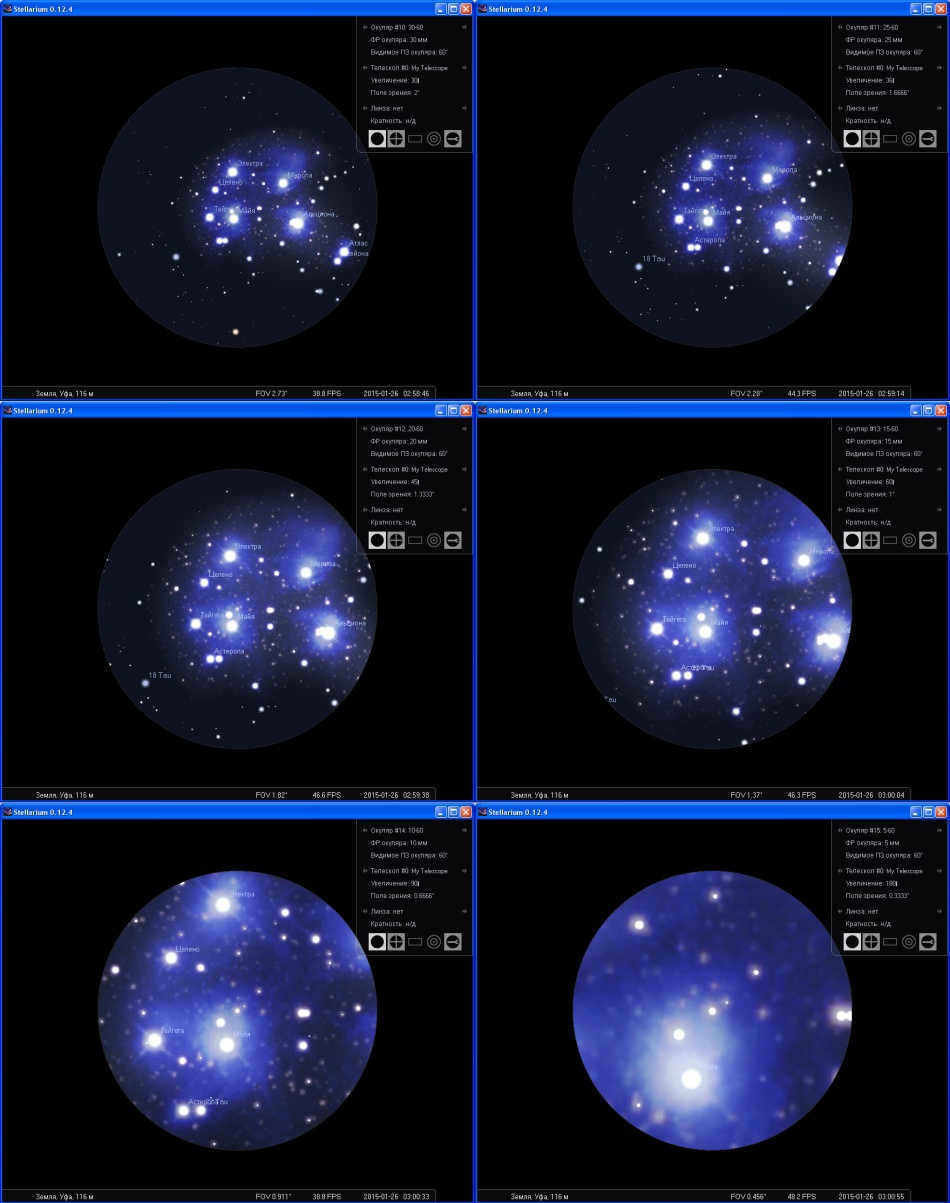
If you’re considering buying an eyepiece, it’s highly recommended to input its specifications into this plugin and explore the various possibilities it offers.
Designing an eyepiece collection
Manufacturers typically include one or two eyepieces and occasionally a Barlow lens with telescopes. If you receive a telescope in a “generous” package with two eyepieces and a Barlow lens, you will have four available magnifications to start with, allowing you to leisurely choose additional attachments in the first few months. The potential magnifications for the telescope can be roughly categorized as follows:
Small. This corresponds to magnifications of 20-50x. At this level, it is ideal for observing the Moon in its entirety, large objects like the Pleiades, and objects that require maximum brightness and contrast. The reason for this is that as magnification increases, the brightness and contrast of the telescope decrease, and for faint objects like nebulae, greater brightness may be more important than size.
Average. This corresponds to magnifications of 50-120x. At this level, you can observe the craters on the Moon and view the planets.
Big. This refers to magnifications greater than 120x. Typically, these magnifications are near the limit for amateur telescopes, so the image quality gradually deteriorates and becomes more dependent on atmospheric conditions. While the Moon displays fine detail at this magnification, personally, I am not fond of the decrease in brightness and contrast, and I rarely use it. At this magnification, you can attempt to find a balance between magnification and image quality for observing planets, as well as aim to see close double stars.
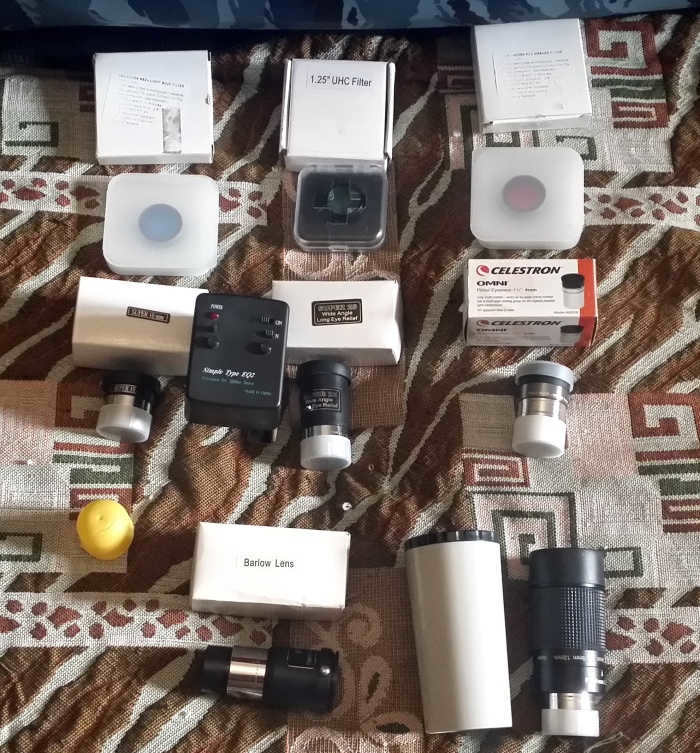
Not just eyepieces
Enhancing the view with light filters
Light filters are an essential tool for improving the quality of images by selectively filtering out excessive light or unwanted portions of the spectrum. These filters come in various types, including solar filters, hydrogen line (H-Alpha) filters, lunar filters, polarizing filters, color filters, dipskai filters, and more. Each filter is designed to enhance specific aspects of celestial observation, providing astronomers with a clearer and more detailed view of the universe.
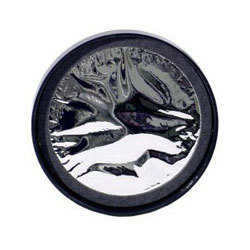
Solar filters are made of a metallized film or specially coated glass. They are positioned on the front opening or lens of the telescope instead of the protective cover, enabling the observation of the Sun through the eyepiece in a manner similar to observing objects at night. Solar filters allow for the viewing of sunspots, flare fields, and granulation on the surface of the Sun.
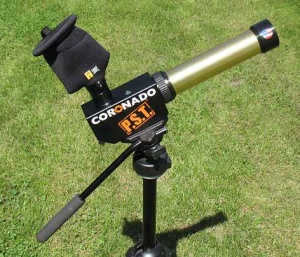
Hydrogen line filters are specialized diffraction gratings that are designed to block out all light except for the specific spectrum of the hydrogen line. These filters are commonly used in the field of astronomy to observe prominences on the surface of the Sun. Currently, there is only one manufacturer that produces hydrogen line filters for amateur telescopes, and that is Coronado. Coronado offers solar telescopes with built-in filters, as well as standalone filters that can be used with other telescopes. Due to the intricate manufacturing process involved, these filters are quite expensive, with telescopes starting at $600 and filters priced around $1000.
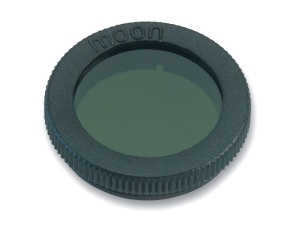
Lunar filters are designed to decrease the overall brightness of the Moon, making it more comfortable to observe. When the Moon is full, its brightness can be overwhelming and make observations unpleasant.
Polarizing filters, on the other hand, offer the ability to adjust the level of brightness reduction on the go, allowing for a range of adjustments from 5% to 25%.
Color filters, on the other hand, are used to filter out specific parts of the visible spectrum. For more information on color filters, you can refer to an informative article that includes a helpful table, which I have provided here:
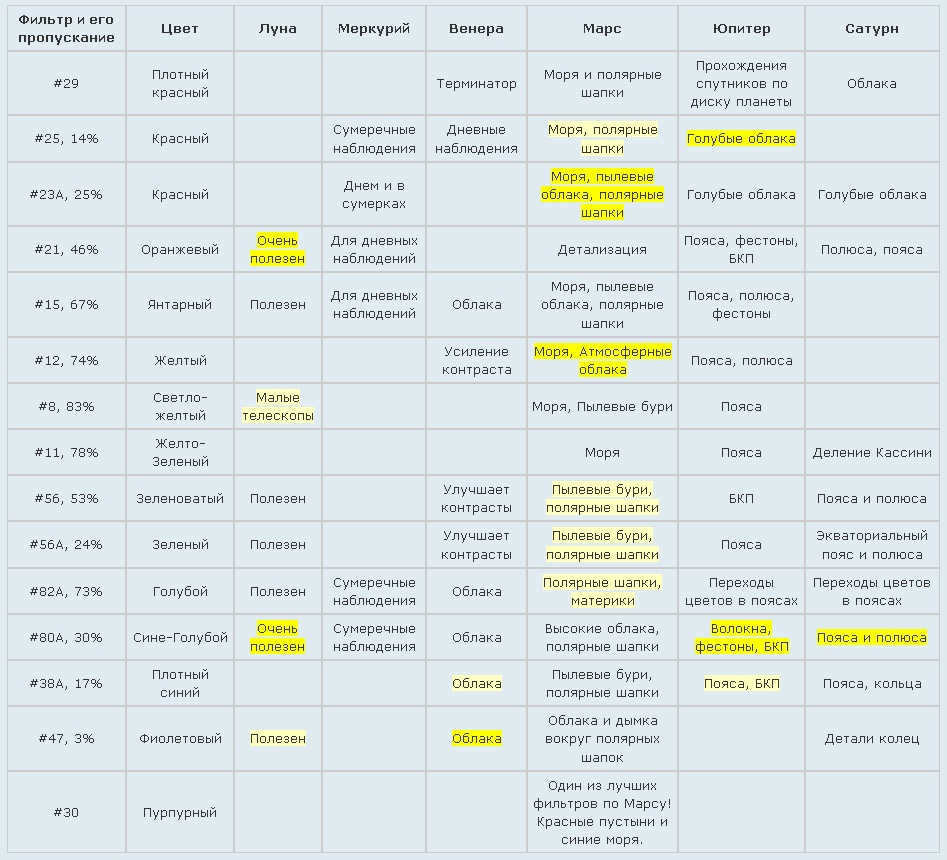
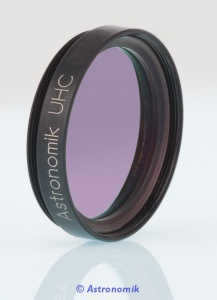
Dipscay filters are specialized filters designed for the purpose of observing nebulae. These filters are available in three variants: UHC (Ultra-High Contrast), O-III (oxygen spectral lines), and H-beta (hydrogen lines). The website also features a table of filter tests related to astronomy, as part of its educational resources.
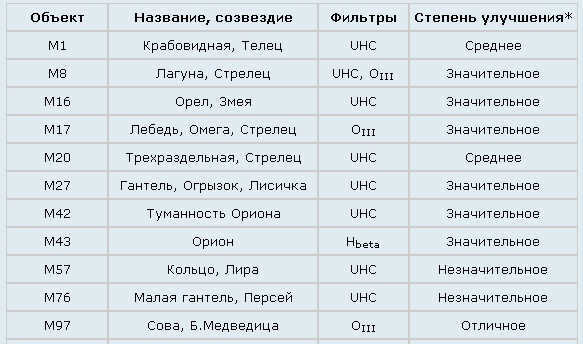
Additional filters can be used to minimize chromatic aberration in achromats (also known as Fringe killers), reduce the impact of city lights, enhance contrast, and more.
My personal encounter with light filters
I possess a pair of filters with distinct colors – an orange filter referred to as #21 and a blue filter referred to as #82A, as well as a UHC filter. In my personal opinion, I have not observed any significant enhancement in terms of quality. It seems to me that the reduction in brightness is more pronounced than any improvement in the image. I utilized the color filters while observing Jupiter, but there was no noticeable improvement. As for the UHC filter, I utilized it while observing M57 and the Great Orion Nebula. Unfortunately, the decrease in brightness outweighed any potential benefits of the filter. However, I must note that my observations were conducted from a balcony, and I have not yet tested the filters under optimal suburban conditions. Perhaps they will yield better results in such an environment. Ideally, the color filters should have been tested on Mars, as it exhibited a very monochromatic appearance this year. Regrettably, I forgot to do so.
Drive mounting
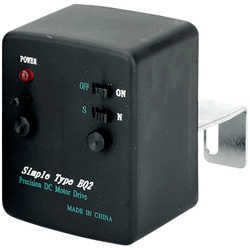
Sky-Watcher offers the EQ1 and EQ2 equatorial mounts that can be enhanced with a mount drive. This compact motor enables the telescope to rotate at the same speed as the Earth’s rotation. It is extremely convenient for individual observations and particularly valuable during stargazing sessions with friends. With the mount drive, you can simply point the telescope at an object and it will automatically track its movement, allowing you to focus on sharing the experience with others. This feature is especially useful when there is a queue of interested people waiting to observe celestial objects, as the telescope will maintain its pointing without the need for manual adjustments.
Alignment Accessories
One essential accessory for alignment is the Kinderspring. What sets it apart is its 1.25″ seating diameter, which allows it to fit perfectly into the focuser assembly. Interestingly, this alignment tool has already been through two astro trips and has proven to be quite durable. It seems that smaller Newton telescopes are better at retaining alignment.
Convenient Bag
If you’re planning to take your telescope out onto the balcony, having a bag can be incredibly useful. I personally have a homemade bag, courtesy of my wife. It’s not too complicated to make one yourself – all you need is some fabric, foam, and a sturdy material like linoleum.
Torch
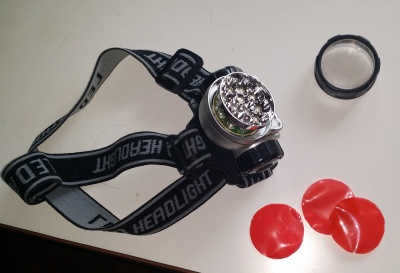
Planning ahead and creating an astroflashlight out of a cheap Chinese headlamp can be incredibly beneficial. Simply attach a red plastic cover, such as one from a folder or similar material, in front of the glass. Many of these headlamps have removable front glass, so it should be relatively easy to modify.
Red Plastic Cover
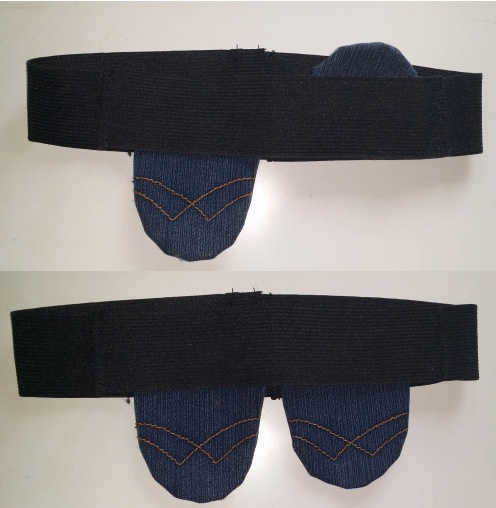
Adjusting your eyepiece for a telescope can be cumbersome, especially when you have to squint or close one eye. However, there are ways to make this process more comfortable. With time, your brain can learn to filter out the image from the other eye, but initially, it can be helpful to use an eyecup. There are various options available, from simple makeshift solutions like a bandage to specialized handmade equipment. I am grateful to my wife for introducing me to these alternatives.
Summary
In summary, creating a comfortable and well-organized space for observing celestial objects can significantly improve the performance of a telescope. This simple astro secret can increase the telescope’s permeability by half a star magnitude. Happy stargazing!
Looking to purchase an eyepiece for your telescope in Russia?
Our team of experts can guide you in choosing the best eyepiece models for your telescope.
We can also provide you with the most up-to-date information regarding availability, payment options, and delivery terms specifically for buyers in Russia.
Easy payment
Full assurance
The eyepiece is a key component of the telescope’s optical system. Its function is to increase the magnification of the image produced by the lens. Originally, the eyepiece consisted of a single lens, but later it was developed into a lens system with a magnification factor known as the multiplicity.
The Role of an Eyepiece in an Astronomical Telescope
The primary function of a telescope eyepiece is to magnify the image. However, in a modern telescope, each component serves multiple purposes to ensure a clear and brilliant picture. Magnification in a telescope is determined by the ratio of the objective lens’ focal length to that of the eyepiece.
In early designs of astronomical telescopes, a single lens was used for this purpose. However, it became evident long ago that high magnification, along with other important parameters such as field of view, image aberrations, and exit pupil, cannot be achieved with a single optical lens.
Thus, the majority of eyepieces are made up of a configuration of lenses that serve several essential purposes, aside from simply magnifying the image:
- Enhancing the reach of the exit pupil;
- Expanding the effective field of view;
- Correcting any aberrations present in the objective and inherent lenses.
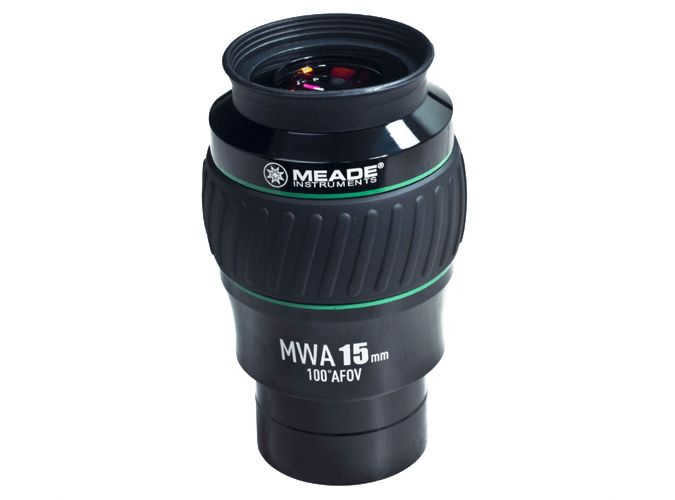

Various types of eyepieces for telescopes
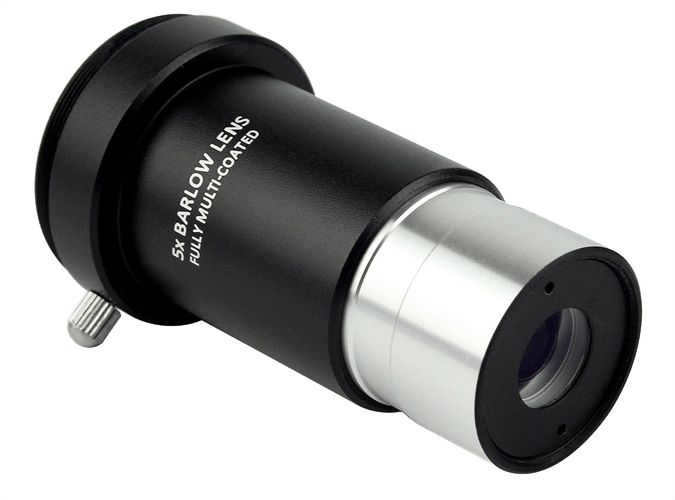
The optical systems of eyepieces exhibit a wide range of diversity. However, among them, there are certain variants that are more commonly encountered:
Ramsden eyepiece – This eyepiece was one of the earliest designs to incorporate two lenses instead of one. The two convex lenses are combined together in a conventional configuration. While it does not provide optimal correction for spherical and chromatic aberration, it does offer some correction for astigmatic aberration.
The primary advantage of this particular eyepiece, and the reason for its continued use in modern times, is its ability to facilitate fairly accurate measurements with the aid of a reticle that can be placed within its focal plane. The reticle is clearly visible within the relatively flat field of view provided by this moderately priced eyepiece.
The Kelner eyepiece is a popular choice among amateur astronomers due to its decent quality. It has a different optical design compared to the Ramsden eyepiece, featuring an additional achromatic lens. This eyepiece is commonly used with telescopes that have a smaller aperture. However, it is not recommended for use when a high magnification is needed.
Orthoscopic eyepieces utilize a four-lens optical system. Three lenses are combined together to create a single unit. These eyepieces are suitable for achieving high magnifications while still providing a good angle of view and exit pupil.
Plössl eyepieces are known for their versatility and are widely used by astronomers. The Plössl design consists of four lenses.





